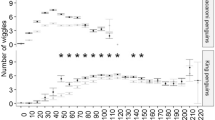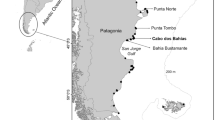Abstract.
Contrasting conditions at-sea are likely to affect the foraging behaviour of seabirds. However, the effect of season on the dive parameters of penguins is poorly known. We report here on an extensive study of the diving behaviour of king penguins (Aptenodytes patagonicus) over the bird's complete annual cycle at the Crozet Islands. Time-depth recorders were used to record dive duration, bottom duration, post-dive interval, ascent rate and descent rate in breeding adults during different seasons in 1995 and 1996. Seasons included summer (n=6, incubation; n=6, chick brooding), autumn and winter (n=5 and n=3, respectively, chick at the crèche stage), and spring (n=4, birds at the post-moult stage). In all seasons dive duration increased with dive depth, but, for a given depth, dives were longer in winter (6.8 min when averaged over the 100–210 m depth layer) than in spring (4.6 min) and summer (4.4 min). The time spent at the bottom of the dives, which probably represents a substantial part of the feeding time, was much longer in winter (2.5 min per dive for dives over the 100–210 m layer) than during other seasons (1.0–1.4 min), i.e. there was a 2.5-fold augmentation for similar diving depths. Ascent and descent rates increased with increasing dive depth, but no difference in the relationships between rates of ascent and descent and dive depth was found among seasons. Furthermore, for all dive depths, ascent and descent rates were independent of the bottom duration. In all seasons post-dive intervals increased with dive duration and with dive depth, but they were longer in spring (2.3 min for dives over the 100–210 m layer) and summer than in autumn and winter (1.6–1.8 min). The diving efficiency decreased with increasing dive depth and was higher in autumn and winter (0.22–0.29) than in summer and spring (0.15–0.18). The large increase in bottom and dive duration from spring to winter is in agreement with the seasonal drop in prey density, with penguins spending more time searching for prey. In contrast, the consistency of the vertical velocity during contrasting conditions at-sea suggests that the transit time to depth is an important component of the foraging behaviour (scanning of the water column) that is independent of the prey availability. The time budget of the penguins during diving in a fluctuating environment appears to vary primarily during the bottom phase of the dives, with bottom duration increasing with diminishing prey supplies, while post-dive intervals shorten in the same time.
Similar content being viewed by others
Author information
Authors and Affiliations
Additional information
Electronic Publication
Rights and permissions
About this article
Cite this article
Charrassin, .JB., Le Maho, .Y. & Bost, .CA. Seasonal changes in the diving parameters of king penguins (Aptenodytes patagonicus). Marine Biology 141, 581–589 (2002). https://doi.org/10.1007/s00227-002-0843-4
Received:
Accepted:
Issue Date:
DOI: https://doi.org/10.1007/s00227-002-0843-4




